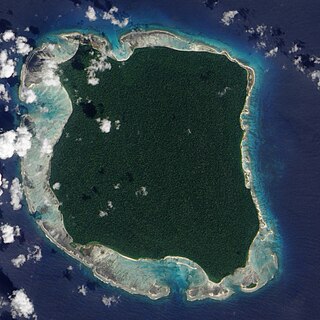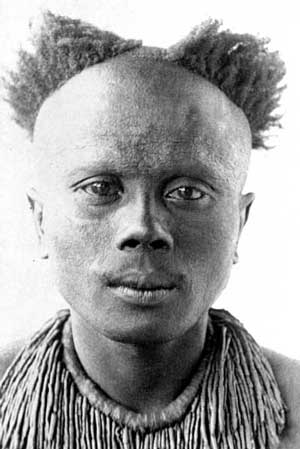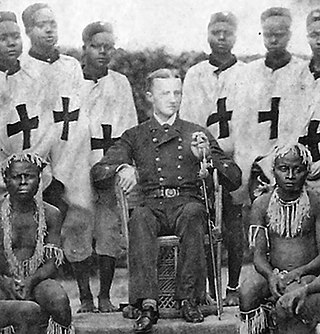
The Andaman Islands are an archipelago, made up of 200 islands, in the northeastern Indian Ocean about 130 km (81 mi) southwest off the coasts of Myanmar's Ayeyarwady Region. Together with the Nicobar Islands to their south, the Andamans serve as a maritime boundary between the Bay of Bengal to the west and the Andaman Sea to the east. Most of the islands are part of the Andaman and Nicobar Islands, a Union Territory of India, while the Coco Islands and Preparis Island are part of the Yangon Region of Myanmar.

The Andaman and Nicobar Islands is a union territory of India. It consists of 836 islands grouped into two island groups: the northern Andaman Islands and the southern Nicobar Islands, separated by a 150 km (93 mi) wide channel. Port Blair is the capital and largest city of the territory, located about 1,190 km (740 mi) from Chennai and 1,255 km (780 mi) from Kolkata in mainland India. The islands are sandwiched between the Bay of Bengal to the west and the Andaman Sea to the east with the northern-most point located 901 km (560 mi) from the mouth of Hooghly river. Indira Point at 6°45’10″N and 93°49’36″E at the southern tip of Great Nicobar is the southernmost point of India.
The Andamanese languages are the languages spoken by the indigenous Andamanese peoples of the Andaman Islands in the Indian Ocean. It contains two known language families, Great Andamanese and Ongan, as well as two presumed but unattested languages, Sentinelese and Jangil.

According to official estimates in India, 10,749 people were killed, 5,640 people were missing and thousands of people became homeless when a tsunami triggered by the 2004 Indian Ocean earthquake near the Indonesian island of Sumatra struck the southern coast on 26 December 2004. The earthquake registered 9.1–9.3 Mw and was the largest in five decades. It was followed by strong aftershocks on the Andaman and Nicobar Islands. The death toll of the earthquake was 1,500 people.

North Sentinel Island is one of the Andaman Islands, an Indian archipelago in the Bay of Bengal which also includes South Sentinel Island. It is home to the Sentinelese, an indigenous tribe in voluntary isolation who have defended, often by force, their protected isolation from the outside world. The island is about 8 kilometres (5.0 mi) long and 7 kilometres (4.3 mi) wide, and its area is approximately 60 square kilometres (23 sq mi).

The Sentinelese, also known as the Sentineli and the North Sentinel Islanders, are an indigenous people who inhabit North Sentinel Island in the Bay of Bengal in the northeastern Indian Ocean. Designated a particularly vulnerable tribal group and a Scheduled Tribe, they belong to the broader class of Andamanese peoples.

The Andamanese are the various indigenous peoples of the Andaman Islands, part of India's Andaman and Nicobar Islands, the union territory in the southeastern part of the Bay of Bengal. The Andamanese are a designated Scheduled Tribe in India's constitution.

The Great Andamanese are an indigenous people of the Great Andaman archipelago in the Andaman Islands. Historically, the Great Andamanese lived throughout the archipelago, and were divided into ten major tribes. Their distinct but closely related languages comprised the Great Andamanese languages, one of the two identified Andamanese language families.

The Onge are an Andamanese ethnic group, indigenous to the Andaman Islands in Southeast Asia at the Bay of Bengal, currently administered by India. They are traditionally hunter-gatherers and fishers, but also practice plant cultivation. They are designated as a Scheduled Tribe of India.
The Jangil were one of the indigenous peoples of the Andaman Islands in India. They lived in the interior of Rutland Island, and were given the name Rutland Jarawa because it was supposed that they were related to the neighboring Jarawa people.
The Jarawas are an indigenous people of the Andaman Islands in India. They live in parts of South Andaman and Middle Andaman Islands, and their present numbers are estimated at between 250–400 individuals. They have largely shunned interaction with outsiders, and many particulars of their society, culture and traditions are poorly understood. Since the 1990s, contacts between Jarawa groups and outsiders grew increasingly frequent. By the 2000s, some Jarawas had become regular visitors at settlements, where they trade, interact with tourists, get medical aid, and even send their children to school.

The Onge language, also known as Önge, is one of two known Ongan languages within the Andaman family. It is spoken by the Onge people in Little Andaman Island in India.

Ongan, also called Angan, South Andamanese or Jarawa–Onge, is a phylum which comprises two attested Andamanese languages spoken in the southern Andaman Islands.

The Great Andamanese languages are a nearly extinct language family once spoken by the Great Andamanese peoples of the northern and central Andaman Islands in the Indian Ocean, and part of the Andamanese sprachbund.

The Kede language, Aka-Kede, is an extinct Great Andamanese language, of the Northern group. It was spoken in the Northern section of Middle Andaman island.

Järawa or Jarwa is one of the Ongan languages. It is spoken by the Jarawa people inhabiting the interior and south central Rutland Island, central interior, and south interior South Andaman Island, and the west coast of Middle Andaman Island.

The Bo was one of the ten indigenous tribes of the Great Andamanese people, originally living on the western coast of North Andaman Island in the Indian Ocean.

Maurice Vidal Portman was a British naval officer, who is best known for documenting and kidnapping some of the Andamanese tribes between 1879 and 1901 when he was posted as a superintendent of the Andaman Island Penal Colony.

Professor Anvita Abbi is an Indian linguist and scholar of minority languages, known for her studies on tribal languages and other minority languages of South Asia. In 2013, she was honoured with the Padma Shri, the fourth highest civilian award by the Government of India for her contributions to the field of linguistics.
Madhumala Chattopadhyay is an Indian anthropologist who specializes in the Indigenous peoples of the Andaman and Nicobar Islands. In 1991, Chattopadhyay and her colleagues were the first outsiders to make peaceful contact with the Sentinelese people.













